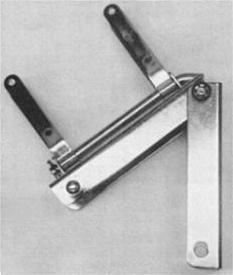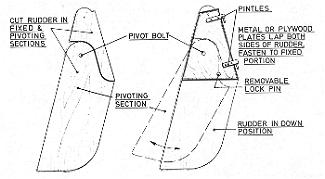Rigging Small Sailboats
Chapter 6
.....deck fittings
Page 3WINCHES
Some comments on winches have been made previously. The variety and type of winches available to the sailor is enormous, but for the small boat sailor, winches usually are restricted to the smaller sizes used to control the jib and Genoa sheets. Winches can be used for the halyards, boom vang, and mainsheets, if desired. On small boats the cost is usually prohibitive, and the extra power gained is not required, as these lines can be handled by the crew or by other means, such as tackles, equally well.

FIG. 6-10 - The rudder is connected to the boat with gudgeons (the fittings on the boat) and pintles (the pin fittings on the rudder). They allow the rudder to swing freely in order to steer the boat |
RUDDER FITTINGS
Small sailboats usually have rudders which are called "outboard" rudders because they hang onto the aft end of the boat in full view. Boats which have rudders under the hull and the rudder stock passing through the hull bottom are said to have "inboard" rudders, but these are usually associated with large boats. The ordinary small boat rudder is attached to the boat with fittings that also allow the rudder to pivot or turn. These fittings are called GUDGEONS and PINTLES. These are arranged in pairs, with the gudgeons usually being attached to the boat, and the pintles fastened to the rudder. The pintles are strap-like fittings with the rudder fitting between the straps, and with a pin at the forward edge which fits into the "eye" of the gudgeons (see Fig. 6-10). As with most fittings, many sizes and types are available. Often gudgeons and pintles come in pairs which have a long pintle and a shorter one. These types make it easier to put the rudder on the boat, as the long pintle will be in position first, thereby acting as a guide for the short one. If both pintles are the same length, both must fit into the gudgeons at the same moment, which is frustrating at times, especially when trying to place the rudder in position when afloat. Because many small boat rudders are made of wood, the tendency is for these to float up and out of the gudgeons, of course, making for an immediate loss of steering and much embarrassment. A device called a RUDDER STOP can be used to prevent this from occuring. These are standard marine hardware items very simple in nature.

|

|
|
FIG. 6-11 - This special factory-made kick-up rudder fitting incorporates the rudder gudgeons and pintles. The fitting mounts to the transom of the boat but allows the rudder to be removed. This fitting is normally used on small boats only. |
|
For small sailboats which land on the beach, it is desirable to have the rudder "kick up" when approaching shallow waters. Special "kick-up" rudder fittings such as shown in Fig. 6-11 are available, which also have the gudgeons and pintles attached as an integral unit, and perform this function. With a little effort, you can make your own "kick-up" rudder similar to the detail shown in Fig. 6-12.

FIG. 6-12 - One method of making a kick-up rudder using wood. When the pin is removed, the rudder will automatically come up when hitting the beach. |